After the Death of Louis Xiv 14th Who Reestablished Their Predominance as Art Patrons?

Filippo Lippi, The Adoration in the Forest, 1459, oil on poplar woods with gold leaf, 118.5 10 129.5 cm (Gemäldegalerie, Staatliche Museen zu Berlin)
Dressed in delicate robes with the edges embroidered in gold, the Virgin Mary kneels on the ground abreast baby Jesus in a dark forest. The Christ kid lays on a blanket of grdonkey and flowers, a translucent veil wrapped around his lower torso. This is substantially a Nativity scene (the moments immediately following the birth of Jesus Christ), a ordinarily depicted subject area in the life of Christ. Nonetheless, as we'll see, this Nascence includes several not-traditional, mystical elements.
At the top of the painting, God the Begetter appears in a dark cloud, dressed in the same red and blueish robes as the Virgin Mary and gazing down with arms spread in a gesture of benediction. A white dove, representative of the Holy Spirit, floats just below the clouds from which God emerges. Beneath God and the dove, golden rays of lite extend down from the heavens. 1 of these golden rays forms a straight line to the newborn Christ child, emphasizing the connectedness between God, the pigeon, and Christ—the three parts of the Trinity, the Christian conventionalities in God'southward tripartite nature.

Saint John the Baptist (particular), Filippo Lippi, The Adoration in the Woods, 1459, oil on poplar forest, 118.five 10 129.five cm (Gemäldegalerie, Staatliche Museen zu Berlin; photo: Dossseman, CC By-SA 4.0)
Continuing to the left of the Virgin and Christ is a young Saint John the Baptist, identifiable past his hair cloak, the fuzzy garment seen beneath his crimson robe . Behind him, an enigmatic figure kneels in the rocky landscape, bowing his head in prayer. John the Baptist holds a staff topped with a stylized cantankerous, around which wraps a fluttering scroll inscribed with the words, "Ecce Agnus Dei" (Behold the Lamb of God)—a reminder of Christ'due south sacrificial office for the conservancy of humanity, co-ordinate to Christian beliefs. The painting's rich, night greens, the soft expressions of its figures, and the gold leaf additions imbue this Nativity with a quiet that merely amplifies the sacredness of the scene itself.
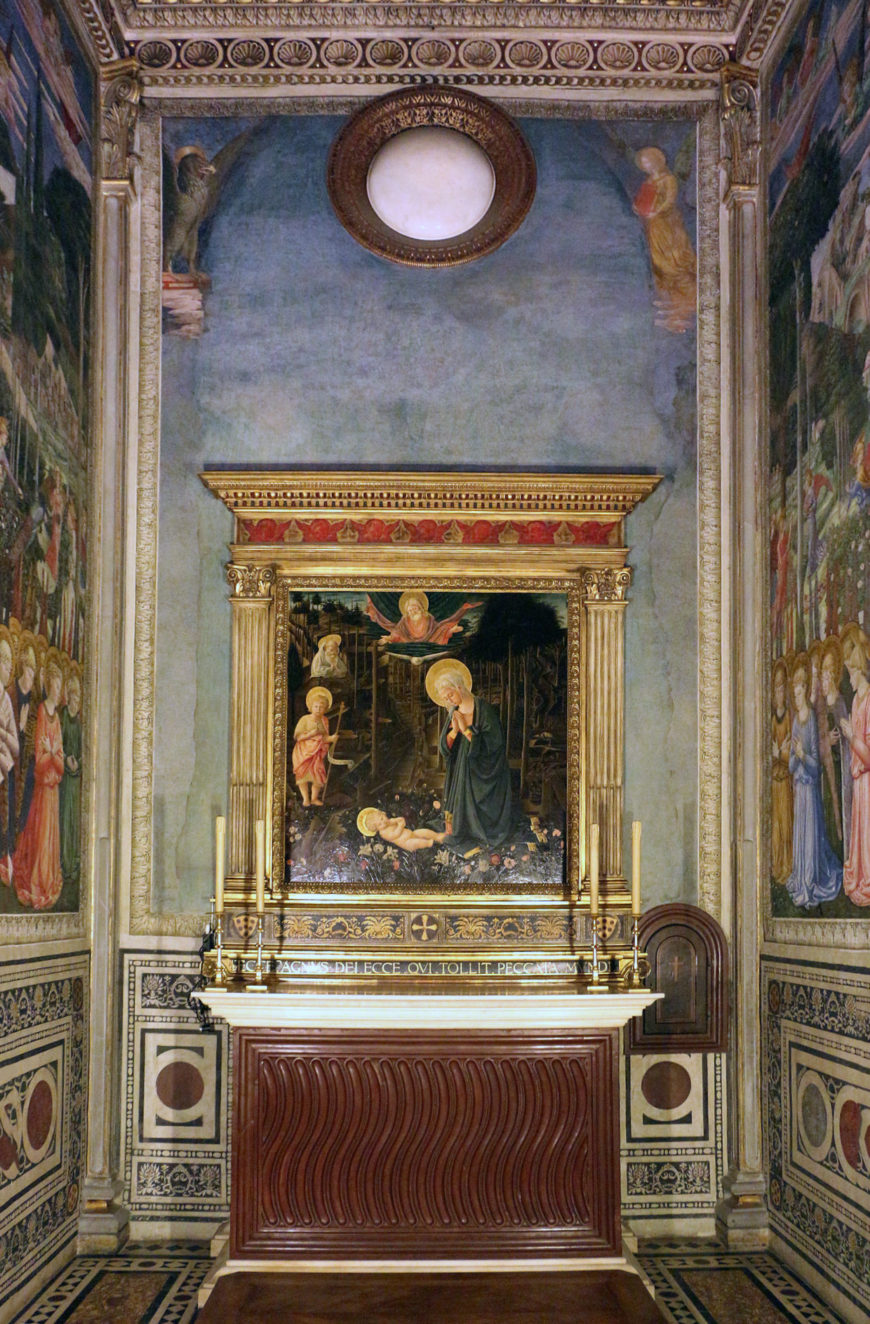
Copy of Filippo Lippi, The Adoration in the Forest, Magi Chapel, Palazzo Medici-Riccardi (photo: Sailko, CC BY 3.0)
Piety, meditation, humility
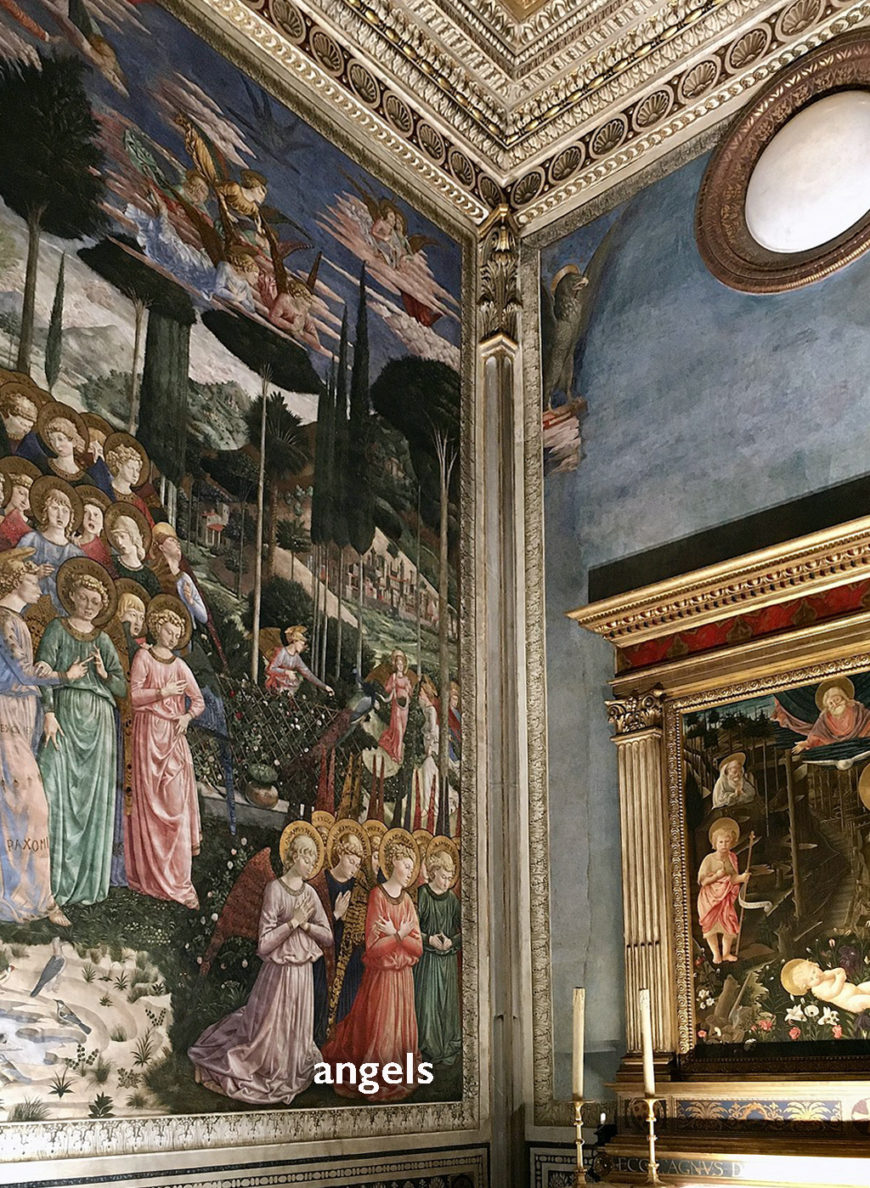
Frescos on the wall, with kneeling angels, next to a copy of Filippo Lippi, The Adoration in the Forest, Magi Chapel, Palazzo Medici-Riccardi (photograph: Manuelarosi, CC Past-SA 4.0)
Completed around 1459, Fra Filippo Lippi'due south Adoration in the Forest (besides known as Mystical Nascency ) was created for Florence'southward Medici family unit and was originally located in the small square apse of the Medici Chapel (or, Magi Chapel) inside the Palazzo Medici in Florence (today known as the Palazzo Medici Riccardi, after it was acquired by the Riccardi family in the 17th century) . The Medici family was a wealthy and powerful Florentine family, whose fortune was built on their banking industry. The Medici Banking concern was initiated in the late 14th century under Giovanni di Bicci de' Medici, only the family unit'due south economical power ultimately helped them garner increased political power, and they became the rulers of Florence (and subsequently Tuscany) for much of the fifteenth through early eighteenth centuries.
Considering information technology was intended for private devotion in a private chapel, this altarpiece is small in comparison to others of its fourth dimension. Lippi's altarpiece was originally situated in the chapel then that the Virgin Mary and the newborn Christ child appeared to exist flanked by adoring angels painted in fresco on the side walls of the chapel itself. The painting is no longer in this space for which it was originally made, although a copy at present hangs there.
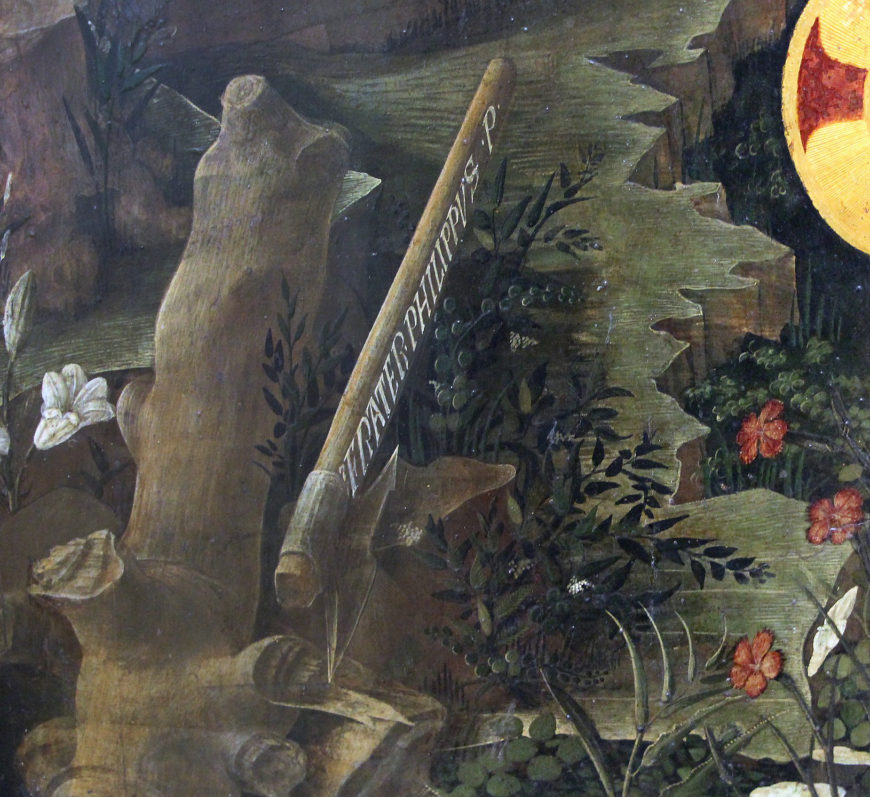
Signature (detail), Filippo Lippi, The Admiration in the Forest, 1459, oil on poplar wood with gold leaf, 118.5 x 129.v cm (Gemäldegalerie, Staatliche Museen zu Berlin; photograph: Беноцо Гоцоли, CC By-SA iii.0)

Virgin Mary and Christ Child (particular), Filippo Lippi, The Adoration in the Forest, 1459, oil on poplar wood with gilded leafage, 118.5 x 129.5 cm (Gemäldegalerie, Staatliche Museen zu Berlin)
Fra Filippo Lippi (whose name is painted on a slice of wood actualization in the lower left corner of the altarpiece) was a Carmelite monk who was known for his characteristically soft and sweet figures. In the center of the work, the artist shows Mary as the Virgin of Humility blazon—not enthroned as the Queen of Heaven, but rather seated on the ground. This way of depicting the Virgin Mary was intended to emphasize her human nature, as a adult female who was chosen to carry God'due south son and would become Queen of Heaven, simply who remains caring and apprehensive nonetheless.
The altarpiece depicts both a biblical scene, that of the Nativity, as well every bit an inspiration to pious prayer. It is meant to encourage viewers to adore and venerate the newly born Christ child. Upon approaching the chantry higher up which this painting was placed, viewers were intended to think about Jesus Christ's life, religious mission, and crucifixion. Just equally the Virgin Mary in the painting gazes lovingly and solemnly at her newborn son, viewers were meant to do the same.
Furthermore, according to Cosmic belief, the bread and wine consumed at the altar during the sacrament of Communion at Mass were consecrated past a priest and converted into the body and blood of Christ. The infant Christ's placement in the center bottom one-half of the painting would accept visually equated the painted image of his torso with the Eucharistic Host (bread and wine) placed in front of it during Mass, and more frequently, with the memory of that Eucharist when a special Mass was not beingness carried out in the space. This careful composition reminded viewers of Christ's humanity, his blood that was shed for the salvation of humankind reflected in the wine that was blessed and transformed during Mass. The painting encourages viewers to pray before it and to contemplate the sacrifices that the depicted babe will afterward brand—and especially to recollect these sacrifices every bit they take part in the sacrament of Communion.
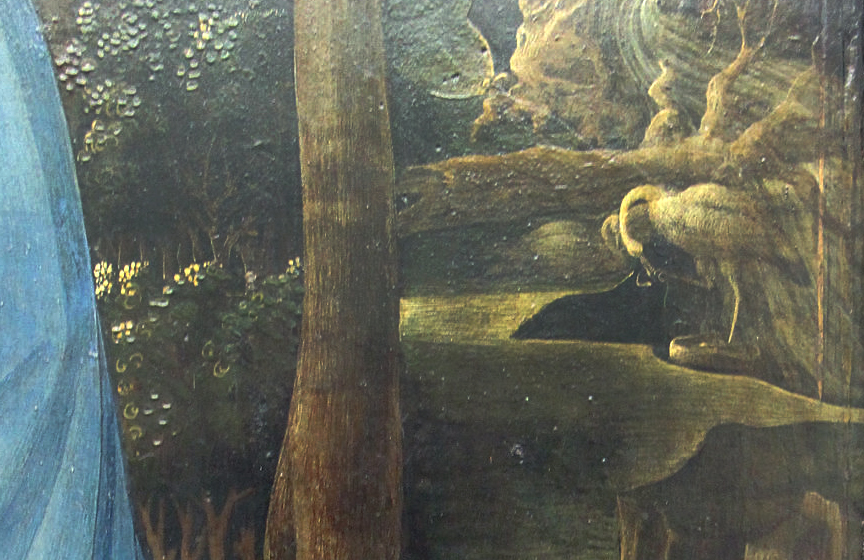
Pelican (detail), Filippo Lippi, The Adoration in the Forest, 1459, oil on poplar wood, 118.5 x 129.five cm (Gemäldegalerie, Staatliche Museen zu Berlin)
Christ's cede is besides symbolically foretold at the far right of the painting, where a pelican reaches downward toward its own breast, recalling the popular medieval anecdote of a pelican who was so attentive to her immature that she pierced her own side to feed them her claret when no other food was available. Just as God so loved mankind that Christ was sacrificed for humanity'southward sins, the mother pelican sacrifices herself to feed her children. At the altar, after the priest carried out the phenomenon of the Mass, the Medici would in turn drink the blood of Christ (in the form of consecrated wine).
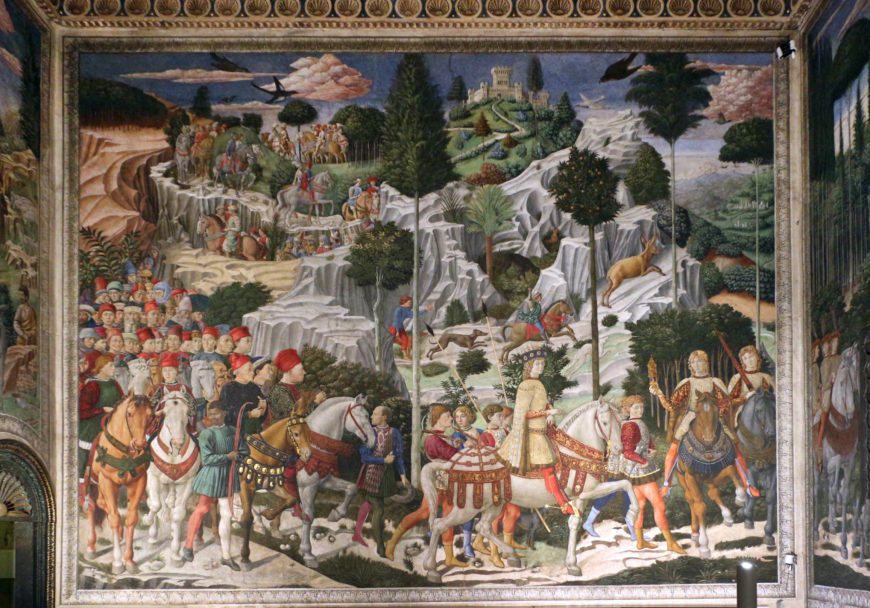
Benozzo Gozzoli, Procession of the Youngest King, Magi Chapel, Medici Palace (photo: Sailko, CC BY 3.0)
A calculated image for the Medici in a chapel fit for kings
The altarpiece was intended to work in tandem with the decoration of the Medici Chapel where it was placed. The frescoed walls of the chapel show verdant landscapes and lush greenery that evoke a paradisiacal world. The placidity, solemn scene of the Adoration in the Forest is distinctly juxtaposed with the bright and lively processions of the Magi that journey across the chapel'southward walls, transporting viewers to a hushed and meditative world. We must likewise imagine the opulent effects of flickering candlelight, causing the gold foliage incorporated in the walls of the chapel and the gold rays and other dots of gold applied throughout Lippi's altarpiece to sparkle and glisten.

Saint John the Baptist and erstwhile man at prayer (detail) Filippo Lippi, The Adoration in the Forest, 1459, oil on poplar wood, 118.5 x 129.5 cm (Gemäldegalerie, Staatliche Museen zu Berlin)
Lippi removed the usual cast of characters found in Nativity scenes (Joseph, the ox, and the ass) and placed the scene in a dark setting. The creative person adds 2 figures who practise not typically appear in paintings of the Nascence: John the Baptist and the onetime human at prayer behind him. This man is thought to correspond the late medieval saint and mystic, Bernard of Clairvaux, a monk who was especially devoted to the Virgin Mary and who was one of the primeval defenders of the theory of her virginity. The saint's mystical writings seem to be reflected in the dreamlike setting of the work, as Bernard of Clairvaux almost appears as a vision, faced towards the lush, enchanting forest and utilizing one of the foreign, mountainous outcroppings as a prie dieu . In addition to theorizing nigh the Virgin Mary's immaculacy, Bernard of Clairvaux also famously wrote against the practice of self-indulgence and preached for true-blue followers to carelessness their cloth possessions to the higher beloved of God. For the wealthy and powerful Medici family, the saint was the exact sort of person with whom they hoped to exist compared. Indeed, past commissioning the Medici Chapel and Lippi's accompanying altarpiece, they were effectively "gifting" this rich, ornate space to the Virgin, Christ, and God. Hither on earth, though, this was a space that was inaccessible to everyone only the Medici and those from whom they wanted to gain favor.
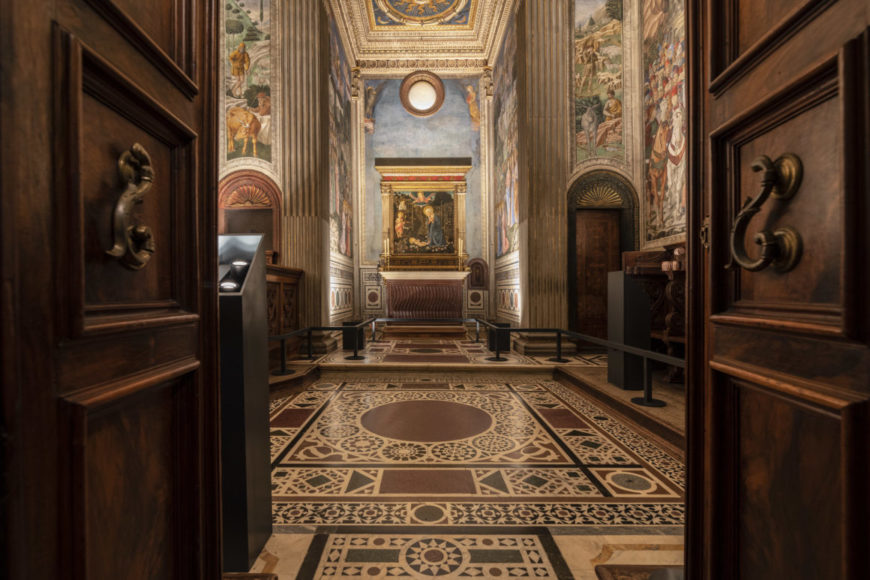
Magi Chapel, with frescoes by Benozzo Gozzoli, Magi Chapel, Medici Palace
Individual, at-domicile chapels similar the Medici Chapel were common for the wealthiest families of Renaissance Europe. For centuries afterward its cosmos, Fra Filippo Lippi's altarpiece represented the Medici's hope for favor from God and would exist used in the family'south Christian devotional practices at their habitation. Kneeling before this altarpiece, many generations of Medici family members prayed in the space of the family'southward individual chapel and considered themselves as contemporary incarnations of the Magi, the iii biblical kings (or wisemen) who visited the newborn Christ child in Bethlehem—the very kings whose long journeys embrace the chapel's walls.
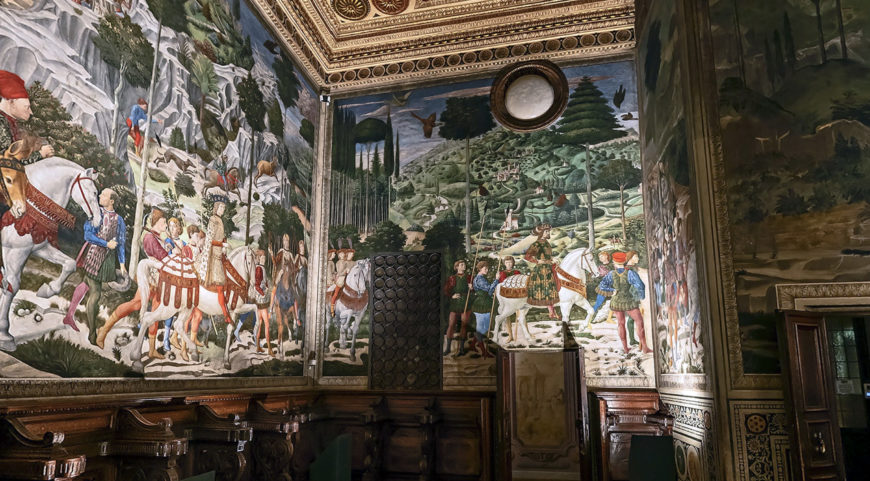
Benozzo Gozzoli, Magi Chapel, Medici Palace
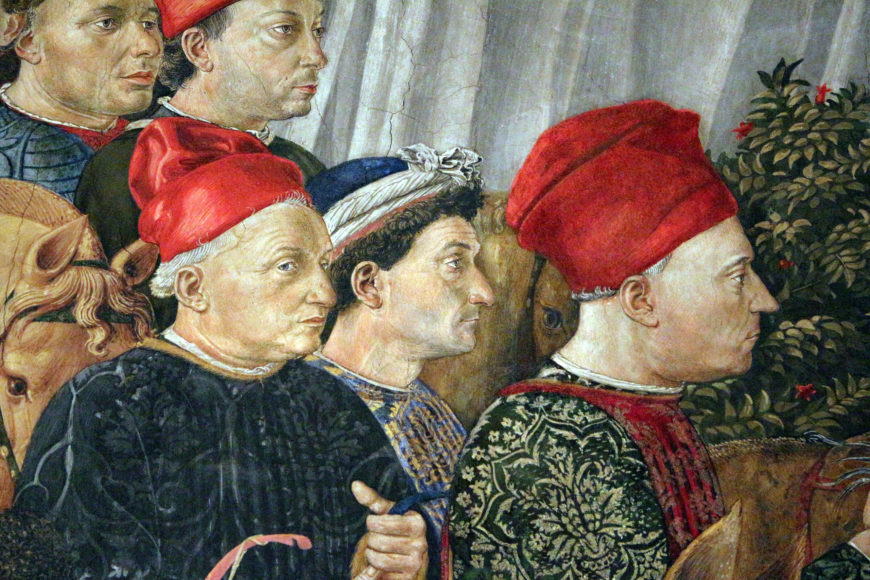
Benozzo Gozzoli, Cosimo and Piero de' Medici (detail), Magi Chapel, Medici Palace (photograph: Sailko, CC Past three.0)
A not-and so-subtle reminder of who this space and this altarpiece were really for, all four walls of the small, almost perfectly square, infinite of the Medici Chapel are frescoed with ornately detailed imagery of the procession of the Magi. However, this procession incorporates much more than than the three kings and the goods that they brought to requite to the newborn Jesus Christ. The kings are shown accompanied by a massive entourage that stretches across the chapel's walls and includes numerous recognizable portraits of members of the Medici family and other powerful figures with whom the family unit hoped to be perpetually continued. This lengthy and opulent procession makes its mode beyond the walls of the chapel toward the Nascence depicted in the altarpiece, reflecting biblical descriptions of the Magi traveling from far and wide to Bethlehem to deliver their expensive gifts to the newly built-in "Male monarch of Kings."
Passed through many hands
This altarpiece also carries a fascinating, turbulent history. In 1494, the Medici were temporarily exiled from Florence after Piero di Lorenzo de' Medici ("the Unfortunate") accustomed an unpopular peace treaty with French republic. The Medici Palace was ransacked and many of import artworks, including Lippi'south altarpiece, were seized by the Florentine Commonwealth and moved to their now reestablished seat of government, the Palazzo della Signoria (too known as the Palazzo Vecchio). When the Medici finally returned to Florence and to ability two decades afterwards, they moved back into their palace and required their looted art to be returned. The Adoration in the Forest then remained in the family's possession for the side by side three centuries.
In the early 19th century, still, during Napoleon's rule in Italia, the altarpiece was sold and acquired by a wealthy English merchant who settled in Berlin. Information technology in that location became part of one of the largest private collections in the globe, simply non for long. During World State of war II, the coveted altarpiece was confiscated by the Nazi party and hidden in a potassium mine along with other stolen artworks, gold, and jewelry. Lippi's Admiration in the Wood was part of the Nazi loot famously salvaged past the American and British group known every bit the Monuments Men in 1945. This fascinating history of its centuries of being stolen, hidden, and sold is a clear reflection of the altarpiece's mesmerizing ability, along with that of the Medici family. The piece of work was eventually returned to Berlin, where it now hangs in the Gemäldegalerie, and a copy resides in its original setting, within Benozzo Gozzoli'south Medici Chapel in the Palazzo Medici Riccardi.
Additional resources
Staatliche Museen zu Berlin, Gemäldegalerie
Keith Christiansen, From Filippo Lippi to Piero della Francesca: Fra Carnevale and the Making of a Renaissance Main (New York: Metropolitan Museum of Art & New Haven: Yale University Press, 2005).
Megan Holmes, Fra Filippo Lippi the Carmelite Painter (New Haven: Yale University Printing, 1999).
Marilyn Aronberg Lavin, "Giovannino Battista: A Study in Renaissance Religious Symbolism," The Art Bulletin vol. 37, no. ii (1955), pp. 85–101.
Barnaby Nygren, "Una cosa che non e': Perspective and Humour in the Paintings of Filippo Lippi," Oxford Art Journal vol. 29, no. 3 (2006), pp. 319–339.
Curtis Shell, "The Early on Style of Fra Filippo Lippi and the Prato Principal," The Art Bulletin vol. 43, no. 3 (1961), pp. 197–209.
Source: https://smarthistory.org/fra-filippo-lippi-adoration/
0 Response to "After the Death of Louis Xiv 14th Who Reestablished Their Predominance as Art Patrons?"
Post a Comment